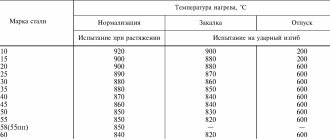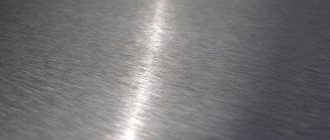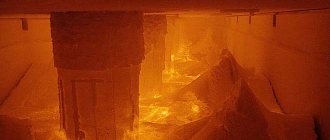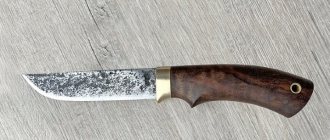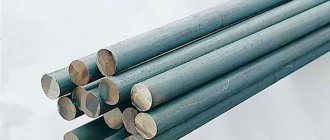Chemical composition of structural steel 35L
The consumer properties of 35L steel are determined by the percentage of carbon and other chemical elements, which are distributed as a percentage as follows:
- iron (Fe) – approximately 97%;
- carbon (C) – 0.32–0.4%;
- manganese (Mn) - 0.45–0.9%;
- silicon (Si) – 0.2–0.52%;
- sulfur (S) – 0.06%;
- phosphorus (P) – 0.06%.
Manganese and silicon are added for good machinability. The proportion of P and S impurities depends on the casting group.
Steel 35 structural carbon quality
A variety of materials can be used to create various parts and mechanisms. Among the metals, steel 35 should be noted. It belongs to the class of high-quality carbon structural steels and is considered the most affordable offer. Steel 35 (GOST 1050-88 previously determined the basic qualities and chemical composition, now it has been replaced by GOST 1050-2013) is used to produce industrial fasteners of various types.
Characteristics of steel 35L
Castings from 35L are produced using the most popular and modern technology for producing cast products - the method of casting using gasified models. This method makes it possible to produce castings from 35L steel with high dimensional accuracy, complete identity of parts in a series, of varying complexity and low cost.
MECHANICAL PROPERTIES:
- yield strength 343 MPa;
- tensile strength 540 MPa;
- relative elongation 16%;
- relative narrowing 20%.
The hardness for metal products 35L (HB 10 -1) is 137–229 MPa.
CASTING PROPERTIES AND DENSITY
| Linear shrinkage | 2,2-2,3% |
| Tendency to form shrinkage cavities | 1.2 ku.r. |
| Tendency to form shrinkage porosity | 1.0 cu.p. |
| Fluidity | 1.0 Kzh.t. |
| Crack resistance index | 0.8 Kt.u. |
35L steel has limited weldability. To avoid the formation of defects during welding, heating to 100–120°C is required, followed by heat treatment. Steel density is 7830 kg/m3.
Physical properties
The main characteristics and application of steel 35 depend on the chemical composition.
The density of the metal decreases with increasing temperature. In the range from 20 to 800 degrees it changes from 7826 to 7600 kg/m3. At the same time, the ductility of steel increases. The density indicator is necessary when calculating the load on load-bearing structural elements.
With increasing temperature, other physical properties of the material also change:
- electrical resistivity – from 251 to 1156*109 Ohm*m at 900 degrees;
- specific heat capacity – 469-699 J/kg*deg;
- linear expansion coefficient – from 12 to 13.9 1/deg;
- the thermal conductivity coefficient decreases from 49 to 28 W/m*deg;
- The modulus of elasticity also decreases in the range of 20-400 degrees from 2.06*10-5 to 1.68*10-5 MPa.
Mechanical parameters
The hardness of the alloy is 163 MPa. The indicator can be increased using heat treatment. Most often, the normalization mode is used for this purpose, which normalizes the metal structure and increases surface hardness.
Application of 35L steel castings
35L steel produced in accordance with GOST 977 88 is relevant in machine tool and mechanical engineering, the construction industry, and in the manufacture of tools. Medium-carbon steel is used for the manufacture of products and parts that function optimally under conditions of average operating (static and dynamic) loads in the temperature range from -40°C to +450°C. AZTL LLC provides single, serial and mass production of the following parts from 35L steel: machine beds, gear wheels, brackets, rods, parts for pipeline fittings, hydraulic turbines, etc.
| Details | Products |
| Heat exchangers | Housings |
| Turbomachines | Beds |
| Rolling mills | Rows, runners |
| Hydro turbines | Tension rings |
| Steam boilers | Floating heads |
| Gears | Flanges, valves, rolls |
| Frames of gyroscopes, stabilizers | Brackets |
| Housing bracket AT 063.00.00.526 | Carbonizer 01.612.115.007.2 | Cover NKR100M-1-1071 for drilling rig NKR100M | Bottom block 7.07.011 for drilling rig SKB-5115 |
| Horseshoe No. 2 | Anchor Admiralty invalid | Cover NKR100M-1-1071 for drilling rig NKR100M | Double flanged slope PTM 316.1-161 |
Application of steel 35
As previously noted, the metal in question is widely used. This is due to the low production cost and fairly high performance characteristics. The alloy is often used to produce the following parts:
- Characterized by low strength and experiencing low stress. This group includes crankshafts, axles, cylinders, rims, traverses and others.
- Various fasteners: bolts, nuts and studs. They are cheap, but cannot be used in the manufacture of wear-resistant parts.
When choosing this alloy, it should be taken into account that due to the fairly high carbon concentration, the degree of weldability is significantly reduced. Therefore, in most cases, workpieces are supplied for machining. Corrosion resistance is average; the resulting parts can be used in moderately aggressive environments. The resulting bolts are often used when constructing foundations or creating other load-bearing structures.
Download GOST 1050-2013
Analogs of steel 35 have similar chemical composition and properties, and are marked when applying GOST standards. Other countries have their own standards. For example, in the USA, analogues are called 1034, 1035; alloys ML35 and ZG270-500 are supplied from China. A more affordable offer is metals produced by domestic companies.
Order steel casting grade 35l
All steel products manufactured at AZTL meet strict GOST requirements and ensure increased purity of the casting structure. You can order and buy 35L steel castings on the company’s website or by phone. It is possible to quickly produce serial castings according to technical requirements, drawings or samples of the customer’s product (part). Call right now - qualified managers will answer all questions regarding ordering, assortment, technical characteristics of metal products, cost, payment methods and delivery.
Technology and features of steel welding
In modern industry, a wide variety of steel is used for welded structures. It can be stainless or ordinary, high or low carbon, heat resistant and so on. Various technologies are used for welding them, but the simplest is welding with a semi-automatic machine or inverter. In this article we will talk about the features of popular types of steel and how to weld them.
Alloy steel welding
Alloy steels are one of the most popular. Their main feature is their composition. Various alloying components are added to it, thanks to which the steel can be given the desired properties and characteristics. Simply put, due to alloying additives, it becomes possible to adjust the composition to your needs.
If necessary, such steel can be made stronger, more durable and better. You can literally change its physical and chemical properties by simply adding alloying elements to the composition.
A few more advantages of alloy steel: increased heat resistance, corrosion resistance (not at the level of stainless steel, of course, but still high resistance). To weld this type of steel, you can use arc welding and electrodes that contain fluorine and calcium. But we recommend gas welding. It is more complicated, but at the same time allows you to get better connection quality.
Gas welding technology, of course, differs from classic semi-automatic or inverter welding. Here the heat is generated not by the electric arc, but by the welding flame. It is formed when a flammable gas mixes with oxygen and burns. The technology of welding carbon steels using gas requires skill and experience. But that doesn't mean you can't experiment. Practice on a scrap piece of metal before doing the main work.
Welding structural steel
Structural steel is used much more often than tool steel. Everything is made from it: from small parts to factory machines. It is this category that includes welding of 40x steel, 30xgsa steel, 35xgsa steel and other other grades.
What is structural steel? This is a very interesting metal in composition. It consists of various impurities, in particular phosphorus and sulfur. The more of these components there are in the composition, the more unreliable the steel will be, so you need to monitor this indicator. Structural steel can be ordinary, high-quality, high-quality and especially high-quality.
As you understand, the latter type of structural steel contains a minimum of impurities, due to which it is possible to obtain truly high-quality and durable metal. Well, ordinary structural steel contains the most impurities; it is considered the most short-lived. By the way, this classification also has separate subgroups (they differ in the presence of some additional chemical components). But we will not describe the classification in detail so as not to confuse you.
Welding low alloy steel
Low-alloy (they are also often low-carbon) steels are metals containing an extremely small amount of alloying elements (usually no more than 2-3%). They consist largely of iron, a small amount of carbon and various impurities.
Low-alloy steels usually include silicon, nickel, tungsten, aluminum, copper and many other metals. By the way, on our website we devoted several articles to aluminum welding and the specifics of the work. We also talked about copper welding. Read these articles to get up to speed.
Low alloy steel can withstand operating temperatures of up to 200 degrees Celsius and is used to make surgical instruments, jewelers' and engravers' tools, as well as razors and blades. And if you add a little chromium to the composition of such steel, you can get a very strong and durable metal. You will have the opportunity to produce any product.
Also, beginners will probably be surprised that low-alloy steel is classified as ferrous metals and bulky welded metal structures are often made from it. And despite the small amount of alloying substances in the composition, it is possible to obtain a truly durable metal. This is possible due to the positive properties of chromium, nickel and molybdenum, which significantly improve the characteristics of low-alloy steel. Also, chromium and nickel improve the anti-corrosion properties of low-alloy steels.
In addition, if the technology is followed, low-alloy steel cooks very well. But here you still need to take into account some features, and this type has a lot of them. Without preparation and a theoretical basis, you are unlikely to be able to weld low-alloy steel. The most common problem is overheating of the welding zone. This feature is observed with many grades of low alloy steels. Also, when welding such steels, very rapid cooling of the weld joint and the metal as a whole is observed, which leads to the formation of mertensite. Mertensite is a hard carbon structure that forms on a weld when it cools too quickly. This is not always to your advantage.
Welding of low-carbon steels is performed using electrodes containing fluorine and calcium. Recommends rods with a basic coating (for example, E42A or E50A coating). The best proven brands of electrodes are UONI 13/45, MR-3, ANO-8, SM-11. You can also use other rods with similar characteristics.
You can also choose semi-automatic or automatic submerged arc welding using a semi-automatic welding machine and filler wire. Instead of flux, you can use carbon dioxide or its mixture with argon. In this case, the quality of the seam will be noticeably better than when using an inverter and electrodes.
